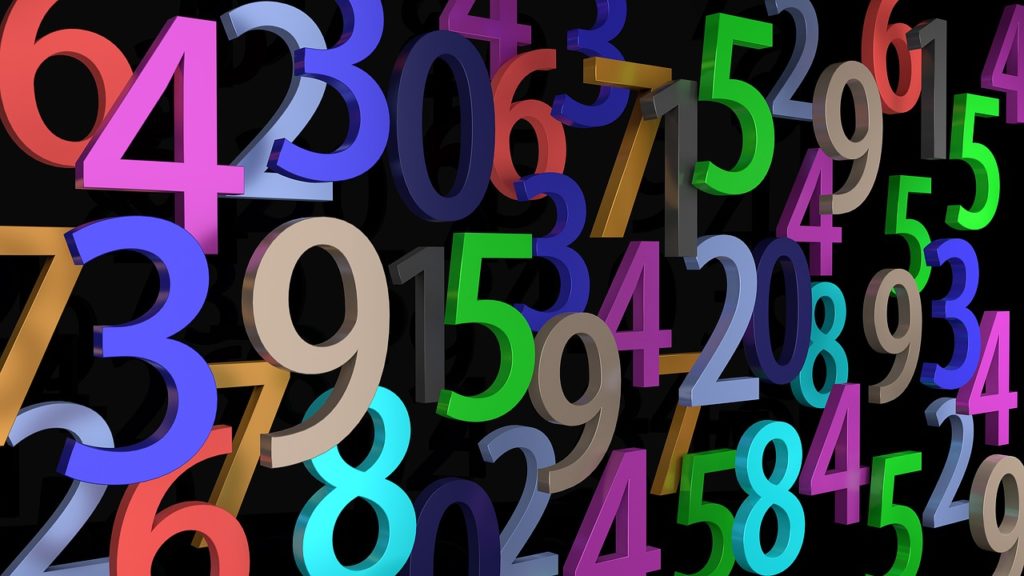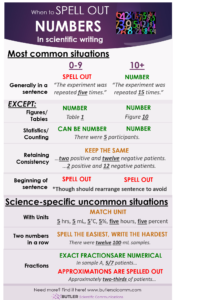When to spell out numbers in scientific writing can be tricky, and how/when to do this is one of the most common questions I get. And I get it…sometimes they are numerals and sometimes they are spelled out, and this can seem both arbitrary and not worth your time to figure out.
If you are anything like I was when writing, sometimes you just have more important things to worry about than stressing over what seems like trivial details – like if your numbers should be spelled out or written as numerals.
Numbers are one of those parts of scientific writing that, when done correctly, blend seamlessly into the overall document and lead to this assumption that they are just a trivial detail.
Unfortunately, incorrectly written numbers can make your paper difficult to understand and can even lead a reader astray when interpreting your science.
Yeesh.
Luckily, the rules for writing numbers are actually quite specific and not so tough once you know what to watch out for.
And here they are, all in one place for your writing needs! Enjoy!
Skip to your scenario
Or straight to the INFOGRAPHIC!

To learn how to spell out numbers in a video
Most common situations for when to spell out numbers
–>Zero-nine – generally spell out
In general, the numbers zero-nine are spelled out when written in a sentence.
“The experiment was repeated five times.”
NOT: “The experiment was repeated 5 times.”
*Exception – Figures/Tables
Figure, table, and equation numbers should always be Arabic numerals.
Figure 1, Table 2, Equation 3
Not: Figure One, Table Two, Equation Three
Dates and times should always be Arabic numerals.
July 4, 1995, 4 July 1995, 10 p.m.
*Exception – statistics/counting
For statistics or counting purposes, the digits 0-9 can be written numerically.
“We detected the protein in 9 of the 10 tested samples.”
“There were 5 participants in the study.”
->10, 11, 12 and higher – generally numerical
In general, numbers 10 and higher are written numerically.
“There were 15 participants in the study.”
NOT: “There were fifteen participants in the study.”
->Retaining consistency within a sentence
When multiple numbers are in the same sentence, it is easier to read if they are either all spelled out or all written numerically.
“The final results showed that 2 patients had no visible benefit from the treatment, 8 patients experienced some tumor shrinkage, and 12 patients experienced complete tumor regression.”
“The final results showed that two patients had no visible benefit from the treatment, eight patients experienced some tumor shrinkage, and twelve patients experienced complete tumor regression.”
Not: “The final results showed that two patients had no visible benefit from the treatment, eight patients experienced some tumor shrinkage, and 12 patients experienced complete tumor regression.”
->Beginning a sentence with a number – always spell out
Any number that starts a sentence should be spelled out, no matter the number.
“Twenty participants returned for the follow-up study.”
Not: “20 participants returned for the follow-up study.”
“Two thousand, two hundred and ninety six participants returned for the follow-up study.”
NOT: “2,296 participants returned for the follow-up study.”
However, writing out numbers at the start of a sentence can get a bit ugly, as seen from the last example above. There are several ways to handle this:
- Add the number in parentheses
“Two thousand, two hundred and ninety six (2,296) participants returned for the follow-up study.”
- Rearrange the sentence to avoid
“For the follow-up study, 2,296 participants returned, and their progress was measured.”
*Exception – chemical names
The one exception is for chemical compounds with a number in their name. Always write this numerically, even when it starts a sentence.
“4-methacryloxy-2-hydroxybenzophenone was the best-performing monomer.”
HOWEVER, I generally suggest ALL sentences starting with a number we reworded to avoid this entirely:
“We found that 4-methacryloxy-2-hydroxybenzophenone was the best-performing monomer.”
->Writing amounts with a unit
The general rules on spelling out numbers zero-nine do not apply when writing a number attached to abbreviated units, generally in materials/methods sections.
The number should match the unit – if the unit is written out, the number should be written out. If the unit is abbreviated, the number should be abbreviated.
For example, all of the following are correct:
5 hrs, 5 mL, 5°C, 5%
five hours, five milliliters, five degrees Celsius, five percent
And you would not want to write
five hrs, five mL, five °C, five %
Uncommon Situations for when to spell out numbers
->Two numbers in a row
When two numbers appear back-to-back, there are two options:
- Spell out the number that is easiest to spell
NOT: “There were 12 100-mL samples.”
“There were twelve 100-mL samples.”
- Rearrange the sentence to avoid the problem
“There were 12 samples of 100 mL each.”
->Fractions
In writing text, fractions should be spelled out, unless an exact quantity has to be conveyed:
- In written text
“Two-thirds of the patients…”
- To convey an exact quantity
“The results showed that 17/58 samples tested positive.”


Pingback: spell out numbers – Priority Articles